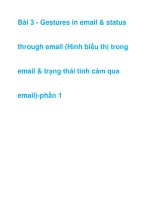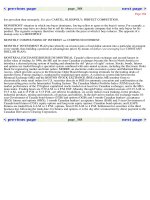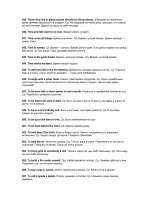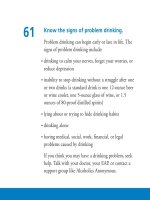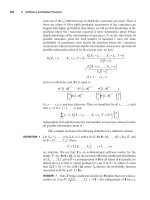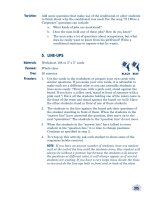betty azar grammar plus phần 6 pdf
Bạn đang xem bản rút gọn của tài liệu. Xem và tải ngay bản đầy đủ của tài liệu tại đây (575.14 KB, 38 trang )
165
4. The first team with three marks in a row wins.
NOTE: You will probably want to explain game strategy such as
blocking, but often the student’s choice is based on which verb
he/she knows.
5. As a follow-up, divide the class into groups of three and use the
worksheet. One student is X, one is O, and the other is in charge
and can have his/her book open to the verb page to judge whether
an answer is correct. After the first game, the students should
rotate roles so that the judge is now one of the players. Continue
until all students have had a chance to be the judge. As you will
see, some of the verbs on the handout take several different
prepositions. As long as the students make an acceptable phrasal
verb, the answer is correct.
NOTE: The items on the worksheet come from the list in
Fundamentals of English Grammar. If this worksheet is not
appropriate to your class, modify it.
Variation: On the grid on the board (or on a modified worksheet), fill in the
squares with both parts of phrasal verbs. When a student selects a
certain square, he/she must use the phrasal verb in a complete
sentence which demonstrates understanding of the meaning. If the
sentence is correct, the student puts his/her team’s mark in that
square.
Example:
ask out do over fill up
get off give up try on
turn off make up hang up
A student from Team X chooses “give up.” The student then makes a
sentence orally: I couldn’t understand the assignment, so I gave up.
The sentence must reflect the student’s understanding of the meaning
of the phrasal verb. A sentence such as I gave up or Don’t give up is
not acceptable. If a sentence is accepted as being correct, the student
writes an X over the square. A student from Team O then chooses a
square and makes a meaningful sentence using that phrasal verb.
Alternate turns until one team has three in a row or the game is a
draw.
3. PREPOSITION BEE
See the directions for the Preposition Bee on page 162. Use
Worksheet 54 or a similar list of your own sentences.
4. BEAT THE CLOCK
Materials: 3”x 5” cards (see sample)
Dynamic: Teams
Time: 30 minutes
Procedure: 1. Put a sentence using a phrasal verb on one side of as many index
cards as you need. Review and discuss phrasal verbs. Have the
students create sentences or dialogues and practice orally.
2. Divide the class into two teams, A and B. Arrange the teams so
that Team A’s desks are directly across from (and touching) Team
B’s desks. If using tables, have Team A sit on one side and Team B
on the other side.
3. Show the students the front of a card. The first student (A or B)
who answers with a phrasal verb that correctly replaces the verb
on the card gets a point for his/her team. If that student can then
use the phrasal verb in a sentence with the correct tense, his/her
team gets an extra point.
Example:
Card: I raised my children in Ohio.
Student response: bring up
I brought my children up in Ohio.
Sample cards:
FRONT BACK
I raised my children in Ohio.
bring up
I met John by chance at the
run into
mall.
Tell Jill to return my call.
call back
Please be sure to arrive for
show up
the test at exactly 8:00.
166
167
5. “UP” VERBS
Materials: 3”x 5” cards
Dynamic: Pairs/Small groups
Time: 20 minutes
Procedure: 1. Write one verb on each card. Choose some verbs that can also be
phrasal verbs with up.
Examples: ask (can’t be used with up)
check (can be used with up)
cross (can’t be used with up)
get (can be used with up)
2. Divide the class into pairs or groups of three or four. Give each
group a stack of verb cards.
3. Tell the students to divide the cards into two piles: verbs with
up/verbs without up.
4. When all the up verbs are found, have the students take turns
explaining the meaning of each phrasal verb to the other students
in the group.
Variation: Make three identical sets of vocabulary cards. Divide the class into
three teams. Tell the students to find the up verbs. The team that
finds the most up verbs wins. Each correct up verb is worth one point.
For each incorrect up verb, subtract one point from the total score. Use
the same procedure for any phrasal verb pattern (for example, out,
away, through, etc.).
6. PHRASAL CHALLENGE
Materials: None
Dynamic: Pairs
Time: 30 minutes
Procedure: 1. Divide the class into pairs. Tell the pairs to write down eight
phrasal verbs and their meanings that they think the rest of the
class will not know.
2. After they are finished, join two pairs and have the first pair
challenge the other pair. Each pair takes turns reading the phrasal
verbs from their list and having their opponents state the meaning
of each phrasal verb and use it in a sentence.
3. If the opponents answer correctly, they get a point. The pair with
the most points wins.
4. For homework, have the students use the phrasal verbs that they
missed in correct sentences.
7. STORY TIME
Materials: 3”x 5” cards, writing paper
Dynamic: Small groups
Time: 40 minutes
Procedure: 1. Divide the class into groups of three, and give each group five
3”x 5” cards.
2. Each group writes down a different phrasal verb on each of their
index cards. You may want to let them use the lists in their books.
Have them write the definition of each phrasal verb on the back.
3. Have the groups quiz each other as to meaning by showing only
the front of the card to another group.
4. Next, each group makes a sentence orally for each phrasal verb.
Rotate the cards again until each group has seen every card and
can make a logical sentence. Monitor the groups during this phase.
5. When the students have a good grasp of the definitions, return
their original phrasal verb cards to them. Each group now writes a
paragraph using all of their phrasal verbs.
6. When the students have finished, rotate their papers clockwise
and the 3”x 5” cards counterclockwise. (Each group will have
another group’s story and a new set of cards.)
7. Each group reads the paragraph and adds a second paragraph,
using their new group of phrasal-verb cards.
8. Have them repeat steps 6 and 7. Each group should now have a
three-paragraph story.
9. Return the original story to each group. Tell the students to look it
over and make any changes they think are necessary. Have one
student from each group read the story to the class. Collect the
stories for a final teacher correction.
168
169
8. CLASS SURVEY
Materials: 3”x 5” cards in four different colors
list of difficult phrasal verbs
sheets of newsprint and markers (optional)
Dynamic: Groups
Time: 40 minutes
Procedure: 1. Choose four themes and for each theme make up a set of questions,
using the phrasal verbs that you want to practice. (You may want
to have the students compile a list.)
Examples:
Family:
Do you take after your father or your mother?
Did you grow up in a large family or a small family?
Do you get along well with your brothers and sisters?
Are you named after anyone in your family?
School:
Do you go over your notes after class?
Do you try to get out of doing your homework?
Do you ever have trouble keeping up with the assignments?
What is an important grammar point that you have to look
out for?
2. Write one set of questions on one yellow card, one set of questions
on one green card, etc.
3. Divide the class into groups. (Four groups of four works well, but
five groups of five or three groups of three also works. Put extra
students into existing groups to work as pairs.)
4. Tell the students that they are going to do some investigation into
the society of the classroom by doing a survey. Give each group a
set of same-color cards and a theme: The Yellow Group—Family;
The Green Group—Friends, etc. Give the question card to the
group leader and a blank card to each of the other members.
5. The group members copy the questions from the group leader’s
card on their own cards so that each has a card with the same
questions. They may add questions of their own if they wish or if
there is extra time. Any additional questions must include a
phrasal verb.
6. When each member has an identical set of questions, the teams
stand up and form new groups with one member of each color. (If
there are extras of one or two colors, they can work as partners
within the group.)
7. In their new groups, the students take turns interviewing each
group member. The yellows ask their questions first and record the
data, then greens, then blues, etc. Everyone asks everyone else in
the group his/her questions.
8. The students reform their original same-color groups, summarize
their findings, and present them to the entire class. If time
permits, have the groups prepare a visual on newsprint in the
form of a pie chart, a graph, a list of statistics, or another type of
visual. The posters can be part of the presentation and later be put
up around the board.
NOTE: To save time, write out the duplicate cards yourself on
colored index cards or copy one set of questions on different-colored
paper. This will take the place of step 5. Collect the cards and reuse
them in later classes.
SUGGESTION: This activity works well with preposition combinations
instead of phrasal verbs.
Examples:
Best Friends:
What do you look for in a best friend?
Is your best friend patient with you?
Do you ever hide anything from your best friend?
Do you ever argue with your best friend?
Work:
Are you content with your job?
Do you look forward to going to work?
Do you forget about your job when you leave at the end of the
day?
Does your boss ever take advantage of you by having you do
extra work?
170
171
Worksheet 50: SCAVENGER HUNT
© 1997 Prentice Hall Regents. Duplication for classroom use is permitted.
Fun with Grammar
With a partner, find the objects on the list. They are all located somewhere in
the classroom. Then write a complete sentence that includes a prepositional
phrase to describe each object’s location.
Objects:
1. 6.
2. 7.
3. 8.
4. 9.
5. 10.
Locations:
1.
2.
3.
4.
5.
6.
7.
8.
9.
10.
172
Worksheet 51: ERROR ANALYSIS
© 1997 Prentice Hall Regents. Duplication for classroom use is permitted.
Fun with Grammar
With your partner, decide whether the sentences desribing the picture are
correct or incorrect. If they are incorrect, correct them.
__ 6. The cat is under the table.
__ 7. The baby is beside the father.
__ 8. The hot dogs are next to the
plates.
__ 9. The chairs are under the table.
__10. The grill is in front of the man.
__ 1. The bird is on the umbrella.
__ 2. The sandwiches are behind the
salad.
__ 3. The spatula is on the man’s
hand.
__ 4. The hammock is between a tree
and a pole.
__ 5. The dog is under the table.
173
Worksheet 52A: PREPOSITION BEE (LOWER LEVEL)
© 1997 Prentice Hall Regents. Duplication for classroom use is permitted.
Fun with Grammar
1. What time do you get up the morning?
2. She is sitting me.
3. The roof is our classroom.
4. I have a doctor’s appointment 10:30.
5. Scott was born June.
6. Do you have any money your wallet?
7. I am standing Sarah and Alison.
8. I’ll meet you the library this afternoon.
9. Our classroom is the office.
10. Before the test begins, please put your books the table.
11. Keiko attends class 9:00 2:30.
12. What time does it get dark night?
13. I’ll be my office after class if you want to talk to me.
14. Please keep your notes your notebook.
15. I’m always cold because there is a ceiling fan directly my
desk.
16. When it’s cold, I wear a sweater my shirt.
17. Hugo works out in the gym Saturday.
18. Where’s my pencil? I don’t see it, but it must be here
somewhere.
19. The back seat is the driver’s seat in a car.
20. I’m going to take my dog for a walk.
21. The children pressed their noses the glass to see what was
inside the store.
174
Worksheet 52B: PREPOSITION BEE (HIGHER LEVEL
)
© 1997 Prentice Hall Regents. Duplication for classroom use is permitted.
Fun with Grammar
1. I’ll meet you 4:00, give or take 15 minutes.
2. Mary was walking from her car when I saw her.
3. It’s raining; you’d better put a coat your dress.
4. Marco was walking the river when he fell in.
5. He set the vase the table.
6. The basketball went the hoop.
7. The sign warned people not to lean the newly painted wall.
8. My partner’s eyes kept closing the entire presentation. It
was so embarrassing!
9. Shut the computer if you are the last to leave.
10. Max is Mexico, but he has lived here for 10 years.
11. You can’t get Jasmine’s attention when she is a group of
her friends.
12. There were many accidents the big storm last week.
13. The glass fell her hands the floor.
14. Because of my allergies, the doctor told me I would have to go
chocolate.
15. My house is located the city limits.
16. Your final essays are due May 27.
17. Jordan was born the last day of July.
18. I sat in the middle seat, Luci and Claudia.
19. Because of all the trees, I can’t see what is those
buildings.
20. Dogs must be their yards or on a leash.
21. Is there any holiday that is celebrated the world?
pay hand look
put try wake
make shut run
do figure grow
find fill tear
ask call drop
write watch pick
look keep hang
hang give fill
175
Worksheet 53: TIC TAC TOE
© 1997 Prentice Hall Regents. Duplication for classroom use is permitted.
Fun with Grammar
176
Worksheet 54: PREPOSITION BEE (PHRASAL VERBS
)
© 1997 Prentice Hall Regents. Duplication for classroom use is permitted.
Fun with Grammar
1. I first asked my girlfriend on a date two years ago.
2. I had a message to call you .
3. Rumi gave on her math homework because she couldn’t
figure the problems.
4. My handwriting was so messy that my teacher told me to do my
homework .
5. Ali is very easy-going; he gets everyone.
6. If the classroom gets too hot, take your sweatshirts and
sweaters.
7. Watch ! There’s a big pothole in the road.
8. The copy machine ran paper, so I couldn’t
make you copies.
9. I need an alarm clock to wake .
10. They are tearing the old building on the corner.
11. I’ll lend you the money if you promise to pay me .
12. Before our teacher hands our tests, she always tells us to
put our books .
13. Yuji is not a serious student; he is always fooling in class.
14. I know this class is difficult, but try to get it.
15. Hitoshi grew in a small town in Japan.
16. Cassio hung the phone before I could ask him about the
homework.
17. I like to buy clothes, but I hate trying them .
18. If you don’t know how to spell a word, look it in the
dictionary.
19. Elena lost her essay and had to start .
20. I ran my former teacher in the parking lot today. I hadn’t
seen him in three years.
Adjectives
9
9.1 IDENTIFYING ADJECTIVES
• Scavenger Hunt
• Opposites Book
• Opposite-Adjective Bingo
• Adjective Charades
• What Does It Remind You Of?
9.2 ADJECTIVES IN SENTENCE CONTEXT
• Match the Description
• Description
• Make a Sentence
• What’s in the Bag?
• Pass It On
• On-the-Spot Reports
9.1 IDENTIFYING ADJECTIVES
1. SCAVENGER HUNT
Materials: Magazines to share
Dynamic: Groups
Time: 15 minutes
Procedure: 1. On the board, write a list of items you want the students to find a
picture of. Each item should include an adjective and noun.
Examples: a happy person an angry person
a sad person an unusual person
a crying baby a crazy person
2. Divide the class into groups of three or four and give each group a
couple of magazines (or assign each student to bring in a magazine
as the previous night’s homework). Another method of distributing
magazines is to keep a pile of magazines on a table and restrict
each group to two magazines at a time. In order to get a new
magazine, they must trade in one of their two. In this way, the
students are not limited to one or two magazines that may not
have good pictures in them, but at the same time, they cannot
“hog” a pile of magazines.
3. The students cut out the pictures so they can show them to the
other groups. You may want them to paste the pictures on paper,
hold them up, or arrange them on their desks or a table. The
students would then circulate to look at them.
4. You may want the groups to vote on which picture is the best
example for each item. These could then be put together on a poster.
2. OPPOSITES BOOK
Materials: Magazines or catalogs, construction paper
Dynamic: Individuals/Pairs
Time: 30 minutes
Procedure: 1. Have students bring in magazines or catalogs to cut up in class. Be
sure there are plenty for them to use. In their magazines, students
look for pictures of opposites, cut them out, and paste each picture
on a separate page. They then label the picture with the adjective
it depicts. (One page might have a picture of someone who is angry,
and the next page have someone looking happy, for example.)
178
179
2. When they have found as many opposites as possible or when time
is up, the students staple the pages together into an “Opposites
Book.”
3. The students can then exchange books to look at the pictures other
students have found to depict opposite adjectives.
SUGGESTION: You can give the students free rein to choose the
opposite adjectives they want, or you can give them a list to find.
The students can easily find pictures of these adjectives.
comfortable/uncomfortable common/uncommon
bad/good happy/sad
healthy/sick important/unimportant
interesting/uninteresting (boring) beautiful/ugly
necessary/unnecessary clean/dirty
pleasant/unpleasant polite/impolite
big/small cheap/expensive
cold/hot dangerous/safe
dark/light dry/wet
empty/full fast/slow
fat/thin hard/soft
heavy/light long/short
messy/neat modern/old-fashioned
noisy/quiet old/young
sour/sweet strong/weak
Variation: By labeling the pictures, the students create a study book for
themselves. For a more interactive activity, before they label the
pictures, the students can exchange books with a classmate and have
the classmate try to supply the adjectives.
3. OPPOSITE-ADJECTIVE BINGO
Materials: A bingo board (Worksheet 55A, 55B, or 55C)
for each student, markers
Dynamic: Whole class
Time: 15 minutes
Procedure: 1. Give each student a bingo board and markers to cover the words
(paper squares, tiles, beans, etc.). You may want to give them time to
look over the words on the board. Explain that when you call out an
adjective, they are to look for and cover up that adjective’s opposite.
For example, if you call out “hard,” the students cover up “soft.”
2. The first person who covers five adjectives in a row is the winner.
Check the answers. If the student has made a mistake, continue the
game. (For variation, you could allow four corners or a cross, etc.)
Variations: Give everyone the same board so they will all hit bingo at the same
time. Or make your own from the blank board (Worksheet 55D). You
might also give the students blank boards and write a list of adjectives
on the board. The students then choose from that list to fill in their
boards in any order they want. Since the words you call off will be
related to the words you write on the board, the students cannot write
in their own adjectives.
4. ADJECTIVE CHARADES
Materials: Worksheet 56, cut up
Dynamic: Teams
Time: 20 minutes
Procedure: 1. Cut Worksheet 56 into pieces and keep them in a hat, box, or bag.
Divide the class into teams.
2. A student from the first team draws a slip with an adjective on it
and must act out the adjective for his/her teammates. Set a time
limit. If the team does not guess it, the other team (or teams) has
a chance to “steal” the answer.
3. Give a point to the team if it guesses correctly in the time limit, or
to the team that steals the answer. Play then passes to the next
team. Continue until all slips have been played or until the time
limit is reached.
5. WHAT DOES IT REMIND YOU OF?
Materials: Worksheet 57
Dynamic: Groups
Time: 20 minutes
Procedure: 1. Divide the students into groups of four. Give each student a copy of
the handout and have everyone fill in the chart under “you” with a
place, person, or thing that the adjectives remind him/her of.
2. Have each student take turns asking the other three members of
the group what the adjectives remind them of. The students then
record this information on their charts.
3. Compare charts as a class by asking who had the same ideas in
their group, who gave an unusual or funny answer, etc.
180
181
9.2 ADJECTIVES IN SENTENCE CONTEXT
1. MATCH THE DESCRIPTION
Materials: Worksheets 58A and 58B or your own cards
Dynamic: Whole class
Time: 30 minutes
Procedure: 1. Give each student two cards: one with a description of themselves
(Worksheet 58A, cut up) and the other of a description of the
classmate they are supposed to find (Worksheet 58B, cut up). Each
student assumes the identity of his/her description from
Worksheet 58A.
2. The students may not look at anyone’s A card. They must circulate
and ask each other questions based on the description of the
person they are looking for.
Example: If John’s B card says “Find someone who is tall and
thin and wearing a basketball uniform,” John must
ask other students questions to find that person. (“Are
you tall?” “What are you wearing?”)
At the same time, the other students will be asking questions to
match their B cards. John should be prepared to look at his A card
to answer questions addressed to him even when he is finished
asking questions.
3. When a match is made, the student with the B card takes the other
student’s A card. The students do not sit down until they have both
given up their A card and received another student’s A card.
4. When everyone has finished, you can ask some questions: “Who is
tall and wearing a basketball uniform?” “Who has short curly
blond hair?” “Who is handicapped?”
Variation: For a less complicated game, keep the B cards but use small pictures
from a magazine instead of A cards. When a match is made, the person
with the description card takes the picture card.
2. DESCRIPTION
Materials: None
Dynamic: Whole class
Time: 15 minutes
Procedure: 1. Have each student write a one-sentence description of a classmate
on a piece of paper, using at least one adjective in the description.
Example: She has long curly hair.
He is wearing a black leather jacket.
She has on a colorful T-shirt.
2. The students take turns reading the descriptions aloud. The rest of
the class tries to guess who is being described.
NOTE: Because students are competing to guess the identity of their
classmates, caution them not to be too general (not “She is wearing
dark blue jeans” if most of the class is wearing dark blue jeans) or
too specific (not “She is wearing a T-shirt with a purple-and-yellow-
striped zebra on it.”). Descriptions that are too general result in a
simple guessing game. Descriptions that are too specific take the
fun out of the game.
3. MAKE A SENTENCE
Materials: Worksheet 59
Dynamic: Groups
Time: 20 minutes
Procedure: 1. Arrange the class in groups of approximately four. Give the cards
from one cut-up worksheet to each group, face down. Tell the
students to deal out five cards per person and keep the others face
down in a pile.
2. The students take turns choosing a card either from the pile or
from another student’s hand, and then discarding. The object is to
make a complete sentence with an adjective in it.
3. When one of the players has a complete sentence in his/her hand,
he/she displays the sentence in order. All the cards in the student’s
hand must be used to make the sentence. If it is accepted by the
group (you can intervene as ultimate judge), the game is over and
that student is the winner. If the sentence does not make sense, is
not grammatically constructed, or contains no adjective, the
student picks up his/her cards and the play resumes.
182
183
While the words on the worksheet are arranged into four-word
sentences, it is possible for the students to come up with other
possibilities using the words on the worksheet. As long as the
students are able to produce a logical sentence of the correct
length, accept their answer.
NOTE: If you are making your own cards instead of or in addition
to using the worksheet, be sure all sentences are of equal length.
4. WHAT’S IN THE BAG?
Materials: 5–12 small paper bags
items for the bags
Dynamic: Pairs/Whole class
Time: 20 minutes
Procedure: 1. Place one item in each bag. You may want to use multiple pieces of
one item, such as seven cotton balls or a handful of pot pourri.
Suggested items:
cooked pasta dry, broken pasta pot pourri
cotton balls flour soil
croutons paper clips
2. Put a list of adjectives on the board. The words will depend on the
level of your class. For example:
Beginner: round, hard, soft, long, small, large
Intermediate: sharp, sandy, sweet-smelling, sour, flexible
Advanced: sticky, rubbery, pliable, brittle, pungent, odorous
3. Using an adjective order chart such as the one in Basic English
Grammar, have students generate words from each adjective
category (opinion adjectives, colors, sizes, etc.). Introduce new
words in each of these categories and write them on the board.
4. Arrange students into pairs and assign each pair a number. Have
each pair write its number on the outside of its bag.
5. The students feel the contents of the bag and then write adjectives
on the outside of the bag describing what they feel. Ask students
to draw from the words on the board.
6. Students pass the bags around so everyone can experience the
contents of each bag. Then have the pairs generate a sentence using
adjectives to describe the contents of the bag they are holding.
7. From the description, the other students try to guess the contents
of the bag. You can have the other pairs call out their guesses, or
for a competition, have each pair write down its guesses, exchange
papers, and show the class the contents to correct the papers.
5. PASS IT ON
Materials: None, or Worksheet 60
Dynamic: Whole class
Time: 15 minutes
Procedure: 1. Choose five students (or ask for volunteers) to leave the room.
2. Before they go, explain to the class that you will send the five
students out and then call them back one at a time. You will tell
the first student a short story and then, when the second student
comes in, the first student will tell him/her what you have just
said. Continue until they get to the fifth student. You should try to
talk at a normal rate that your students can understand, perhaps
even a little faster. Do not purposely slow down to tell the story.
3. Have the five students leave the room. Follow the steps explained
in step 2.
4. You can make up your own story or use an example from the
worksheet. If you make your own story, be sure to include plenty of
adjectives.
5. The class (and you) will judge how well the story got passed along.
6. To play again, select five different students and a different story to
pass along.
NOTE: The other students in the class should not coach or help the
students who make errors in content when relaying the stories. This
should be stated before doing the activity.
SUGGESTION: For fun, tape record both the first and final versions
of the story. Then play them back for the whole class.
6. ON-THE-SPOT REPORTS
Materials: None
Dynamic: Pairs/Small groups
Time: 20 minutes
Procedure: 1. Before class, ask a student to help you participate in a role play (or
choose two students to do the role play). Bring in different types,
colors, and patterns of clothing. The two actors “disguise”
themselves with the clothes. One of the actors is the “thief” and
the other, the “victim.” (If you are taking one of the roles, you
might want to play the thief.)
184
185
2. At the beginning of class, the “victim” comes in and walks in front
of the class (perhaps as if looking for a place to sit or going out an
opposite door—it depends on your classroom). The “victim” has a
purse or backpack or some other article for the “thief” to steal. The
“thief” rushes in behind the “victim” and grabs the agreed-upon
article. Both exit, with the “victim” now chasing the “thief.”
3. The two actors remove their “costumes” and leave them out of
sight of the rest of the students.
4. Arrange the students in pairs or small groups and have them
prepare “statements” for the police. The statements describe what
they witnessed, details about what the “thief” was wearing, and a
description of the stolen object.
5. Read the statements aloud or have students read them aloud so
the class can agree on the best report of the incident. You can also
show the clothes and see which group came closest.
186
Worksheet 55A: OPPOSITE-ADJECTIVE BINGO
© 1997 Prentice Hall Regents. Duplication for classroom use is permitted.
Fun with Grammar
happy
soft
cold
new
loud
calm
difficult
interesting
dry
cool
cheap
sweet
FREE
dirty
attractive
intelligent
sharp
funny
empty
slow
round
light
large
short
smooth
187
Worksheet 55B: OPPOSITE-ADJECTIVE BINGO
© 1997 Prentice Hall Regents. Duplication for classroom use is permitted.
Fun with Grammar
smooth
short
large
light
round
slow
empty
funny
cheap
intelligent
attractive
dirty
FREE
sweet
new
cool
dry
interesting
difficult
calm
loud
sharp
cold
soft
happy
188
Worksheet 55C: OPPOSITE-ADJECTIVE BINGO
© 1997 Prentice Hall Regents. Duplication for classroom use is permitted.
Fun with Grammar
happy
cold
cool
sweet
dry
cheap
funny
slow
intelligent
empty
round
sharp
FREE
light
loud
difficult
dirty
calm
interesting
attractive
new
short
soft
large
smooth
189
Worksheet 55D: OPPOSITE-ADJECTIVE BINGO
© 1997 Prentice Hall Regents. Duplication for classroom use is permitted.
Fun with Grammar
FREE


